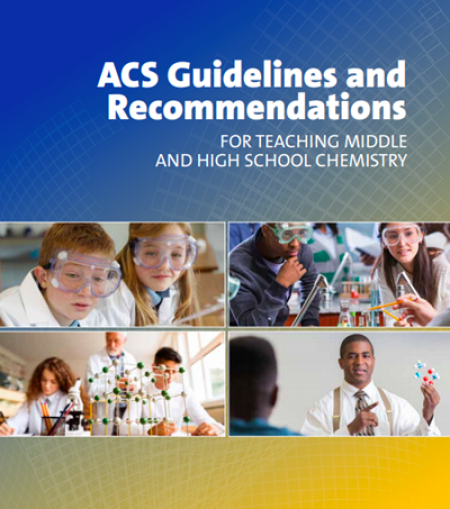Strategies
Select a Strategy
Lesson Formats | Questioning | Problem Solving | Modeling | Scientific Terminology | Choice | Student Reflection
Lesson Formats
Teachers can capitalize on the importance of chemistry in everyday life to engage their students. Teachers should follow through with opportunities for students to actively explore and struggle with new concepts in a way that allows them to embrace three-dimensional learning.
To motivate students and deepen their understanding of chemistry, instructors need to plan thoughtful lessons in advance and establish clear learning goals. Allowing students to reflect on their knowledge complemented by effective questioning from the instructor helps them solidify concepts.
Planning Is Crucial
Advanced planning is crucial for active student engagement. As guided by local and/or state curriculum guidelines, teachers should decide on the conceptual learning goals, with focus on chemical principles and concepts within the core ideas in chemistry.
Spiraling the curriculum (building on and making connections to what students have already learned) encourages student participation and understanding. Making the material relevant to students’ lives will also promote engagement in their learning.1
Teachers should highlight guiding questions at the beginning of each lesson to focus the attention of both teachers and students on the key learning objectives for the lesson. This pedagogical approach fosters participation and inclusion of learning via the three dimensions.
Several lesson formats such as guided inquiry, modeling, and investigating a problem promote deeper understanding by students.
Other Appropriate Formats
Other effective lesson formats appropriate for some topics in chemistry include role playing, manipulation of concepts via simulations, and differentiated instruction. Cognitive science discourages “teaching as telling,” therefore careful planning is necessary to avoid this pitfall. If a lecture format is decided to be the most effective way to teach a concept, allow students to preview the information and provide them in advance with organizers to maximize participation and promote student understanding.
The 5E Lesson Plan
The 5E Learning Cycle Model allows teachers to initially engage students, then students explore through experimentation, explain or summarize their new learning, and elaborate through application, and finally students evaluate their claims.
The expanded 7E lesson plan adds an elicit step at the beginning and an extension step before students evaluate their claim.
Questioning
Assess Student Understanding by Questioning
Regardless of the lesson format that is chosen, teachers must prepare appropriate questions to assess student understanding during each phase of the lesson. These questions include:
- an engaging question at the beginning of a lesson to determine what students already know,
- probing questions during the lesson to guide student learning,
- closing questions at the end of the lesson to gauge what students learned.
Engaging Questions
The engaging questions should be answered by students with the understanding that students don’t have to have the “right” answer; the purpose of these questions is to generate initial ideas.
- Diagrams and drawings allow for students to develop an initial conceptual model for their current understanding.
- A lesson about intermolecular forces could begin with a question about how water pollutants dissolve in water. Often these questions uncover naive ideas or misconceptions that will be addressed later in the lesson.
- Students could be presented with a provocative question related to their lives or provided with a puzzling discrepant event to challenge prior conceptions.
- Many chemistry teachers enjoy beginning a lesson with a demonstration or video clip that makes students think about the topic in a different way. Sometimes a simple demonstration paired with a good question is sufficient to spark student learning.
Probing Questions
During a lesson, effective probing questions help students develop their ability to solve problems. The questions should help students make connections to other learning. To determine what students truly understand, open-ended questions are more effective than questions that have only one answer or questions that can be answered with yes or no.
Closing Questions
At the conclusion of the lesson, it’s a good idea to ask a closing question, which allows students to consider what was discussed during the lesson and provides feedback to the instructor about possible misconceptions that were generated. Using the responses to the closing questions can allow the instructor to prepare appropriate engaging questions for the following lesson.
Try It: What Are Bubbles?
While pouring water from a pitcher into a beaker, ask students, "What are the bubbles made of?" This encourages students to think more deeply about everyday experiences.
Next, heat the beaker of water on a hot plate and discuss the difference between the small bubbles viewed initially and the large bubbles that form when the water boils.
Ask students how they can test their ideas about the composition of the bubbles rather than provide a step-by-step procedure or explain the answer without allowing them to struggle with the concept. This leads to a deeper understanding of the concept for students.
Problem Solving
Chemistry students must become good problem solvers. This is an active, sometimes confusing process, which is often frustrating but frequently rewarding. Thomas Edison didn’t invent the light bulb by following a recipe; he developed more than 1,000 faulty light bulbs before figuring out how to make one work.
Students must learn to explore problems and understand that taking a “wrong” step is often just as valuable as following the correct path. Students should be observant and self-critical during the problem-solving process to evaluate whether they are getting closer to or farther from the desired solution.
Act Like a Teacher, Think Like a Pro
Model your thinking to help students understand how experts work through a problem:
- Teachers should model their own thinking to help students understand how experts work through a problem: Start with the given information, put the pieces together, and evaluate whether students arrive at a solution that seems reasonable. Students must evaluate whether their answer is reasonable; learning to estimate mathematical answers is crucial to problem solving.
- Cooperative learning strategies could be used to help students solve meaningful real-life problems.
- To avoid cries of, “Why do we have to know this?” from students, teachers should develop a context for learning. See the Try It example.
Try It: Real-World Investigations
Have your students work in teams to investigate local air quality, learn the nutritional value of their favorite foods, or discover the effects of fertilizer on water quality.
This is not a textbook topic, but it requires students to apply textbook knowledge to real-life scenarios.
Modeling
Much of chemistry deals with macroscopic phenomena that cannot be physically observed at the atomic level. By developing and modifying models, students can refine their understanding, and eventually develop a consensus model. Deliberately teaching that all models have limitations allows new types of models to be introduced to further explore the depth of the concepts and recognize limitations in facets of understanding. Then, to help students understand these abstract concepts, carefully prepared analogies and models can be used.
Visualizations of phenomenon with computer-based models, such as PhET simulations and videos and graphics on middleschoolchemistry.com, are great tools to describe how changing particle motion and organization relate to chemical processes. AACT also has a host of digital simulations and animations to use in the classroom.
Modeling molecular motion and particle arrangement is common at the middle school level, but at the high school level, Lewis dot structures and molecular compound models are commonly used to describe chemical phenomenon. In addition, mathematical equations such as gas laws are also used at the high school level to justify observations.
Scientific Terminology
Students can use vocabulary to hide misconceptions. For instance, students may be able to define density mathematically, as well as state that an object will float in water if its density is less than 1 g/cm3. But when asked why, students may be unable to explain floating in terms of particle organization.
Vocabulary should be introduced near the end of the lesson to give names to the concepts the students have come to comprehend more thoroughly.2 Effective modeling and three-dimensional assessments can help a teacher know what his or her students know.
Choice
Many students can demonstrate achievement of course goals when they have the option to choose how to express their understanding through alternative modes such as by delivering an oral presentation, creating a portfolio, or completing a creative project.
Some students require a structured environment, so chemistry teachers should provide explicit instructions and rubrics for assignments in advance.
Giving students a choice in the chemistry classroom enriches their understanding of the content and improves student motivation when they are actively involved in learning and allowed to share their perspectives.
Student Reflection
Providing students time to reflect on their new knowledge helps ensure their understanding endures past the closing bell.
- Ask students to complete exit cards with prompts, such as “Today I Learned …,” “I would still like to know more about …,” or “I still don’t understand…”.
- Students can write a letter to a relative or a friend explaining in nontechnical terms what was learned in chemistry that week.
- Students can keep a journal or search for real-world examples as evidence of topics learned in class.
- Add new rules or evidence to a student-generated or classroom-public model to build understanding.
References:
- Helping students find relevance. Psychology Teacher Network, September 2013.
- Tellier, J. P., Quantum Learning and Instructional Leadership in Practice. Corwin Press: Thousand Oaks, CA, 2007; pp 133, 158.
ACS Guidelines and Recommendations
for Teaching Middle and High School Chemistry
An essential resource for middle and high school physical science and chemistry teachers, curriculum developers, principals, and other school administrators who support teachers in those roles.
Learn about the nature of instruction, the core ideas to teach, the physical instructional environment, safety, sustainability, and the professional responsibilities of teachers.




